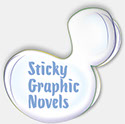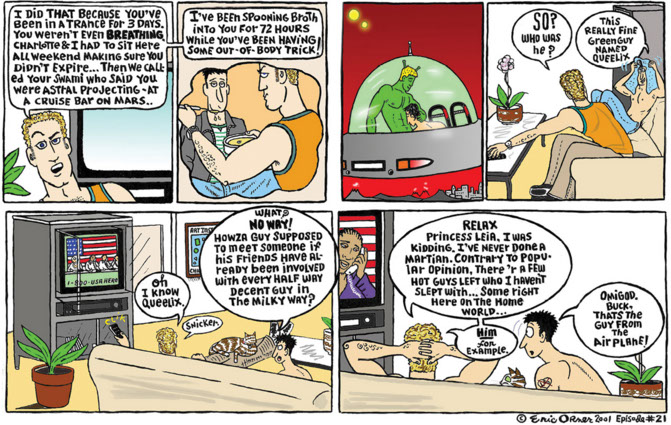- GUTTERFAGS -
Quarterly reviews of sequential art about
dude-on-dude lust and love
-- Back to the front page for more reviews!
Gutterfags is sponsored by Sticky Graphic Novels, an imprint of gay character-based, sex-positive graphic novels published in hardcover by Bruno Gmünder GmbH and in digital format by Class Comics.


The Completely Unfabulous Social Life of Ethan Green
by Eric Orner
reviewed by Larry Duplechan for Gutterfags
I recently rediscovered Eric Orner's Ethan Green comics when a friend (aware of my love of gay male writing, gay male art and – relatively recently – gay male graphic novels) decided the near-complete (apparently, a few strips have been lost forever) collection, The Completely Unfabulous Social Life of Ethan Green, would make a good Christmas "stocking stuffer" for me. On first blush, it struck me as the literary equivalent of a fruitcake: I vaguely remembered the Ethan Green comics from twenty-plus years previous, having seen them in The Advocate, or maybe Frontiers – it was a long time ago – and vaguely remembered not liking them very much. I found Green's stark, scratchy black-on-white drawing style and his purposely grotesque characters (even the "pretty" people aren't actually pretty) less than pleasing to my eye. And his sad-eyed, banana-nosed scribble of a protagonist appealed to me considerably less than, for instance, the rippled, nippled residents of the late A. Jay's Harry Chess comics, which predate Ethan Green by a couple of decades (A. Jay's art style was similarly cross-hatchy, but even his villains were good looking); or Jerry Mills' perpetually smiling, balloon-muscled Billy, star of the Poppers series which (prior to Mills' untimely death in 1993) briefly coincided with Ethan Green. I remembered even more vaguely the 2005 epic misstep of a film based on the comic series, which (all-too-typically) relocated the action from the Boston to West Hollywood, and cast blond prettyboy Dan Leterle in the title role. Voice of Experience: that's Hollywood.
The good news is that, upon re-reading, Ethan Green proved to be a good bit more enjoyable than I'd remembered (rather like a Pet Shop Boys album from the same era). I found Orner's art, while definitely stark and scratchy, also surprisingly evocative; achieving believable human anatomy and facial expressions both subtle and explosive, with an economy of line sometimes bordering on frugal. And, as often happens with popular art, Ethan Green, having run from 1989 to 2005, stands as a quirky little time capsule of East Coast middle class gay male subculture at a particularly eventful and turbulent time in its history – something no one could have known 20 years ago.
The action unfolds around (and to, and occasionally in the mind of) Ethan Green, thirtyish Caucasian gay Everydude – office worker, resident of urban Boston, vacationer in Provincetown and Toronto. Ethan's supporting cast include handsome (well, Orner's off-kilter version of handsome) and hunky BFF Bucky (subject of seemingly unending unrequited sexual tension); Charlotte, Ethan's Lesbian-of-color buddy and voice of reason (a Sapphic Hattie McDaniel in jeans and Birkenstocks); his orange tabby cat, Lucy, who (in a device going back at least as far as Edward ("Krazy Kat") Herriman in the early teens of the 20th Century), occasionally acts as a feline Greek Chorus, commenting upon the action in speech balloons; Madame Zolna, Ethan's cigarette-smoking, crystal-ball-gazing "fortune teller", the frequent voice of Ethan's own projected hopes, fears and desires; and perhaps most significantly (certainly, for my money, most enjoyably), Ethan's dual Queer Sages, a pair of campy, gay militant cross-dressing bears referred to only as "the Hat Sisters". The Hat Sisters befriend, nurture, advise and teach Ethan (both by word and example) throughout the series, always with campy wit and hard-won wisdom, often with a brightly-colored cocktail in hand: exemplars of mature gay behavior for us all.
As might be expected, Orner's strips served up slices of gay life in Boston/P'town at the segue of the 20th Century into the 21st, covering the Gay Hit Parade of subjects (coming out, dates both good and heinous, Pride festivals, STDs) in the expected venues: The Gym (flirting, gossip, inevitable stirring up of both one's libido and one's body dysmorphia issues), The Bar (cadenzas on how various gay men dance or flirt, often at the same time), The Beach (in the very first strip, the collective boom-boxes – yeah, it was a long time ago – of the inhabitants of the gay beach, all playing "Vogue", create a Madonna-shaped cloud in the sky above, as a Speedo-clad observer remarks "It's a miracle is what it is …").
The through-line, to the extent that there is one, rides the Six Flags roller coaster arc of Ethan's on-again/off-again (on-again, and so forth) love affair with the (literally) too-good-to-be-true Leo, which arc includes an on-again/off-again rebound romance with co-worker Doug, which includes the all-too-authentic appearance of a troublesome third party named HIV. After a period of blissful dating, Doug breaks it off with Ethan (one in a series of breakups), without explanation, seemingly without reason. As it turns out, Doug has HIV. His eventual explanation, delivered across a coffee-shop table ("I couldn't give myself over to 'us' knowing that ultimately, I'll get sick") might or might not seem realistic in the age of the "Truvada whore", but the scene resonates for at least one generation of gay men, and it rings as true, and cuts as deep as a Paul Monette essay or the final scene of "Longtime Companion". Many of us have heard variations on that speech; some long-term survivors have delivered one or two variations.
If there is "bad news" here, it is largely due to the fact that there are, by definition, a lot of strips here (it is a "complete" collection, after all) and no one hits a home run every ups. Some of Orner's out-of-left field flights of fancy can land just shy of the target: strips involving Ethan falling into his own brain (seen as a rather cramped room full of file cabinets) like Alice into Wonderland, Ethan dreaming of falling in love with the robot from the "Lost In Space" television show or the cleaning-product logo "Mr. Clean", or the unrelated-to-the-through-stories pair of moon-landed astronauts who fall tragically in love (and when I say tragic, I mean tragic), vary in entertainment value and bear the birthmarks of work done because the artist had a contract and a deadline, and wasn't quite sure what to do next.
Also, as a collection of one- and two-page strips not necessarily created with a view to an exhaustive collection, things get a bit samey (again, rather like a Pet Shop Boys album). The consistency of Orner's characters (what David Bowie called "always crashing in the same car") can smear into monotony, and there are only so many times any artist/writer – even one as skilled as Orner – can keep The Gym, The Bar and The Beach consistently fresh over a sixteen year run.
- About the reviewer -
Larry Duplechan is the Lambda Literary Award-winning author of Blackbird, Got 'til It's Gone, and three others. His other hobbies include drawing dirty pictures.